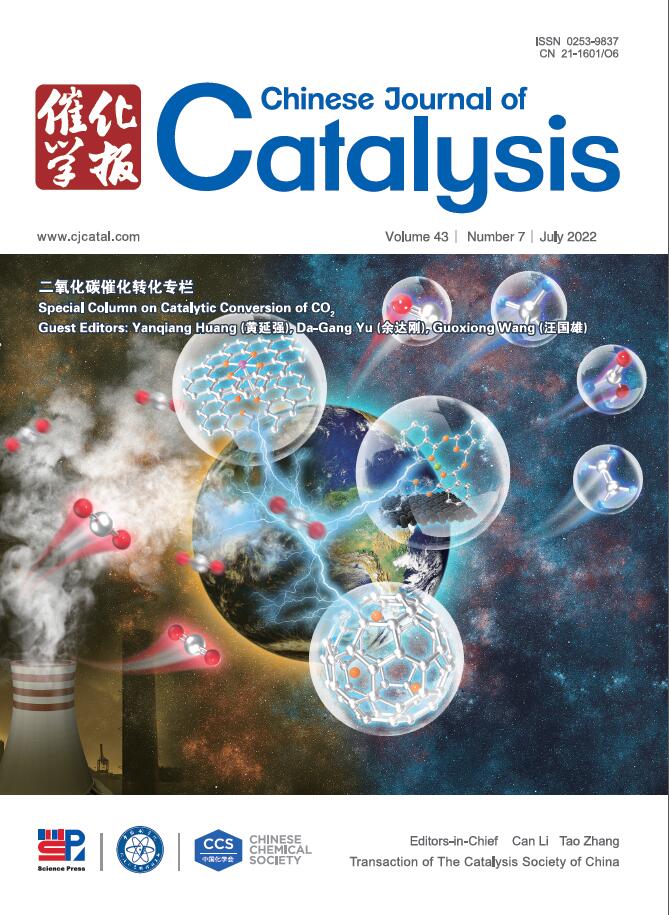Advances in spin regulation of M-N-C single-atom catalysts and their applications in electrocatalysis
IF 15.7
1区 化学
Q1 CHEMISTRY, APPLIED
引用次数: 0
Abstract
To enhance the efficiency of green energy harvesting and pollutant degradation, significant efforts are focused on identifying highly effective catalysts. Metal-nitrogen-carbon single-atom catalysts (M-N-C SACs) have emerged as pivotal in catalysis due to their unique geometric structures, electronic states, and catalytic capabilities. Notably, the incorporation of magnetic elements at the active centers of these single-atom catalysts has garnered attention for their role in efficient electrochemical conversions. The orientation of spin states critically influences the adsorption and formation of reactants and intermediates, making the precise control of spin alignment and magnetic moments essential for reducing energy barriers and overcoming spin-related limitations, thereby enhancing catalytic activity. Thus, understanding the catalytic role of spin and modulating spin density at M-N-C single-atom centers holds profound fundamental and technological significance. In this review, we elucidate the fundamental mechanisms governing spin states and its influence in electrocatalysis. We then discuss various strategies for adjusting the spin states of active centers in the M-N-C SACs and the associated characterization techniques. Finally, we outline challenges and future perspectives of spin regulation for high-performance catalysts. This review provides deep insights into the micro-mechanisms of catalytic phenomena and offers a roadmap for designing spin-regulated catalysts for advanced energy applications.
M-N-C单原子催化剂自旋调节及其在电催化中的应用研究进展
为了提高绿色能源收集和污染物降解的效率,人们正在努力寻找高效的催化剂。金属-氮-碳单原子催化剂(M-N-C SACs)由于其独特的几何结构、电子态和催化性能而成为催化领域的关键催化剂。值得注意的是,在这些单原子催化剂的活性中心加入磁性元素已经引起了人们的注意,因为它们在有效的电化学转化中的作用。自旋态的取向严重影响着反应物和中间体的吸附和形成,因此精确控制自旋排列和磁矩对于减少能量障碍和克服自旋相关限制至关重要,从而提高催化活性。因此,了解自旋的催化作用和调制M-N-C单原子中心的自旋密度具有深远的基础和技术意义。在这篇综述中,我们阐明了控制自旋态的基本机制及其在电催化中的影响。然后讨论了调整M-N-C SACs中活性中心自旋态的各种策略以及相关的表征技术。最后,我们概述了高性能催化剂自旋调控的挑战和未来展望。本文综述了催化现象的微观机制,为设计先进能源应用的自旋调节催化剂提供了路线图。
本文章由计算机程序翻译,如有差异,请以英文原文为准。
求助全文
约1分钟内获得全文
求助全文
来源期刊

Chinese Journal of Catalysis
工程技术-工程:化工
CiteScore
25.80
自引率
10.30%
发文量
235
审稿时长
1.2 months
期刊介绍:
The journal covers a broad scope, encompassing new trends in catalysis for applications in energy production, environmental protection, and the preparation of materials, petroleum chemicals, and fine chemicals. It explores the scientific foundation for preparing and activating catalysts of commercial interest, emphasizing representative models.The focus includes spectroscopic methods for structural characterization, especially in situ techniques, as well as new theoretical methods with practical impact in catalysis and catalytic reactions.The journal delves into the relationship between homogeneous and heterogeneous catalysis and includes theoretical studies on the structure and reactivity of catalysts.Additionally, contributions on photocatalysis, biocatalysis, surface science, and catalysis-related chemical kinetics are welcomed.
 求助内容:
求助内容: 应助结果提醒方式:
应助结果提醒方式:


